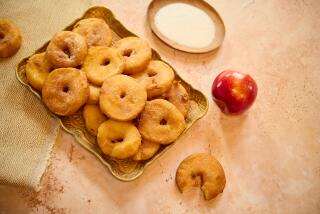Struggle in the Skillet: The Drama of Frying
- Share via
Most of us have a sort of love-hate relationship with frying. Well, more of a love-fear relationship, really. On the one hand, there’s the sheer pleasure of eating fried food. On the other, there’s the knowledge that too much fat isn’t good for us.
If fried foods didn’t absorb so much oil, we might not feel so guilty about eating them. But that greasiness is where much of the flavor comes from. Take it away and you end up with foods like baked potato chips--they’re certainly not like regular potato chips and not much like baked potatoes either.
In trying to avoid the nutritional hazards of frying, we end up with a sensory hazard instead. Maybe we should accept the fact that if we’re going to fry, we can’t escape the oil. All fried foods absorb oil. What we should do is try to understand how the oil is absorbed, the better to minimize the damage.
Like many other cooking methods, frying primarily involves drying out the food being cooked. This drying not only creates a thin, crisp crust on the outside, the heat that causes it also turns the water inside to steam, cooking the food. This creates the bubbling turbulence usually associated with frying.
As the steam is pushed out, oil is absorbed into the gaps left by the evaporation. As the heat penetrates deeper into the food, more water turns to steam, creating pressure that resists more oil being absorbed.
The tricky part is that during this whole process, the chemistry of the hot oil is changing. But that’s tricky only in terms of understanding the chemical process. You don’t have to understand it all to cook, which is why you rarely find chemical engineers working at the local drive-through.
Moreover, the oil actually needs to break down, or degrade, for it to fry more efficiently, because water--the primary component of most food--and oil don’t naturally mix. That takes surfactants, wetting agents that are related to soap and help the oil better adhere to the food’s surface. Surfactants are the result of reactions involving oil, heat and the food being cooked.
And you thought French fries were easy. Michael Blumenthal, program director at Libra Technologies Inc., a food technology firm in Metuchen, N.J., and adjunct professor at the Rutgers University Department of Food Science, has been studying how deep-frying works for more than 30 years.
He says you can trace the quality curve of cooking oil in a French fry. “When oil is really fresh, it doesn’t cook well at all. French fries cooked in really fresh oil will be white on the outside and raw on the inside. They’ll be a little bit raw and they won’t have real good flavor,” he says.
“As the surfactant level builds up, the next stage is break-in oil. German bakers used to take a ladle of old oil and add it into a vat of new oil, and that would transfer enough surfactant to make the fresh oil work. With break-in oil, you begin to get some coloring, the surface is beginning to dry, you’re beginning to get some crust formation. The inside is beginning to cook through and the starch is beginning to gel.
“Next, you go up to the optimum frying situation, where you get French fries pretty enough to use in advertising. They’ll be golden yellow with a nice crisp crust and a fully gelled interior. The color will be very uniform and the flavor will be delicious.
“The next step is degrading oil. You begin to get over-dehydration and excessive water loss. The walls of the French fry collapse inward and the edges begin to become really hard and dry. The interior begins to hollow out because the gel inside has lost so much water that it collapses. The French fry is becoming quite limp, and some of the starch is breaking down and sugars are coming to the surface and being overheated by the oil so you get black spots.
“Finally, you get to what we call a runaway situation. You can’t make good French fries no matter what you do. And the chemistry of the oil that is absorbed into the French fry is so extreme that you don’t feel well after eating it.”
Home cooks can approximate the bakers’ trick by adding 2% or 3% old oil to the fresh oil (about 1 teaspoon per cup of oil).
Blumenthal says one good oil test for home cooks is to watch the smoke that comes up during cooking. “When oil is fresh, you’ll get a light white smoke coming from the surface; that’s just evaporating water. When the oil is broken in, you’ll get a white smoke that really smells delicious. When you start to see darker gray or blue smoke, that’s when the oil is distilling small molecules, and those are serious breakdown products.”
There are, of course, some foods that are inherently oilier when fried than others. Compare a potato chip to a French fry. The chips have a surface-to-volume ratio more than 10 times higher than the standard fry, so they have a lot more surface to absorb oil. The fat content in a French fry with a 10x10-millimeter cross-section is only 9% whereas that in a potato chip is 40%--not to mention any dip you might be using.
Similarly, foods that are more moist tend to absorb more fat. As mentioned above, oil absorption occurs as moisture is removed from foods during frying, and the more water gets removed, the more fat can be absorbed through the capillaries and cracks left behind. The amount of oil absorbed in this way is nearly equal the amount of water that is evaporated.
How much oil food absorbs also depends on how long the food is fried. If it’s fried too long, it will overcook and all the water inside will boil away. The result can be a dry product with an overly thick and excessively oily crust. That’s OK for potato chips but not for other things, as we all learned at school cafeterias.
The last factor affecting oil absorption is oil quality and composition. And the most important aspect of that is how saturated the fat is. A saturated or monounsaturated oil is a heat-stable oil. Palm oil, olive oil, peanut oil, vegetable shortening and animal fats such as lard and beef tallow are all high in saturated and monounsaturated fats. They will better resist the inevitable breakdown. Therefore, they’ll be less readily absorbed by the food at higher temperatures.
Nonetheless, the degradation process can’t be stopped, only slowed. Ultimately, after repeated use, oil uptake begins to increase substantially and the food begins to become overly dark. The oil foams excessively, starts to smoke or smell bad or take on “off” flavors. The oil is then said to be in the runaway stage.
One byproduct of runaway oil is polymer, which Blumenthal describes as “that sticky stuff that forms on your pan above the oil line.” A byproduct of oil, polymer is the cause of a lot of fried food’s reputation for causing indigestion. It is also what keeps food from sticking to a properly seasoned cast-iron pan (the process of seasoning is essentially building up a polymer coating that seals the pores in the metal).
At this point the oil should be discarded. In many European countries, in fact, there are laws requiring oil to be thrown out when it reaches this stage. There is no such regulation in the United States.
After all that, though, fried food is still going to be fatty and it will still taste great. It will never be health food. It will never be good for your body. Is it good for your soul? Well, that’s a personal decision.
* Glass serving bowls in photo avove from Museum of Contemporary Art, Los Angeles.
* Missouti Frying Fundamentals, H12
More to Read
Eat your way across L.A.
Get our weekly Tasting Notes newsletter for reviews, news and more.
You may occasionally receive promotional content from the Los Angeles Times.










